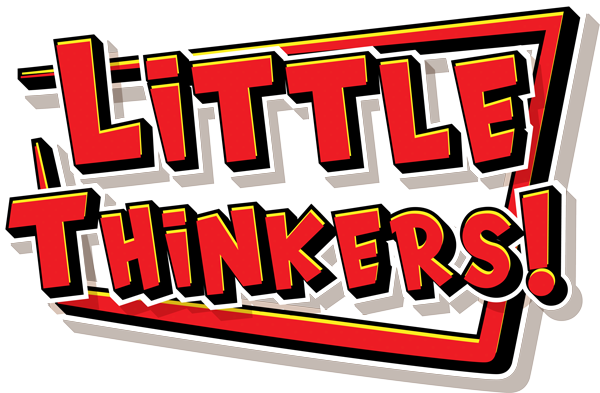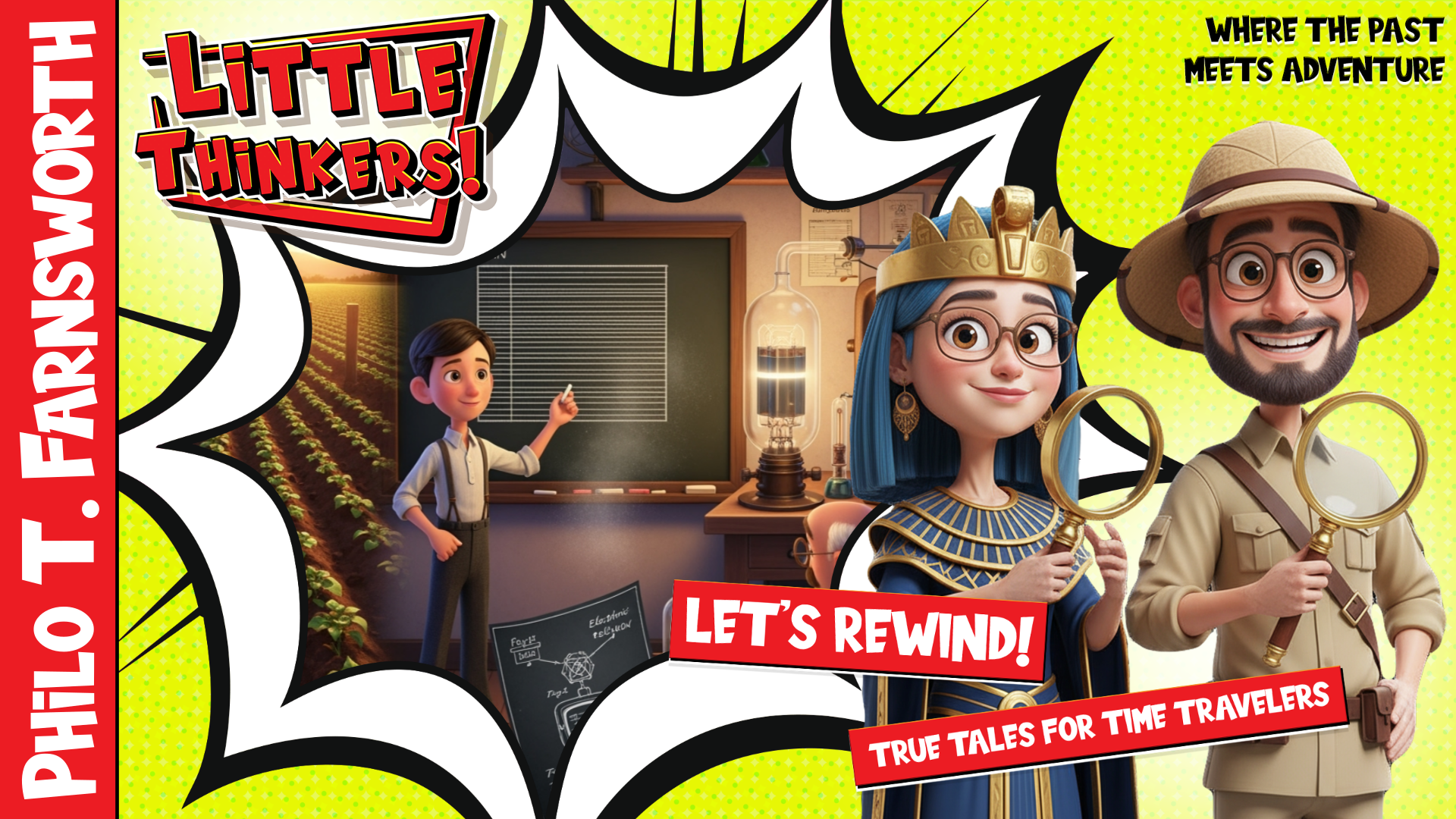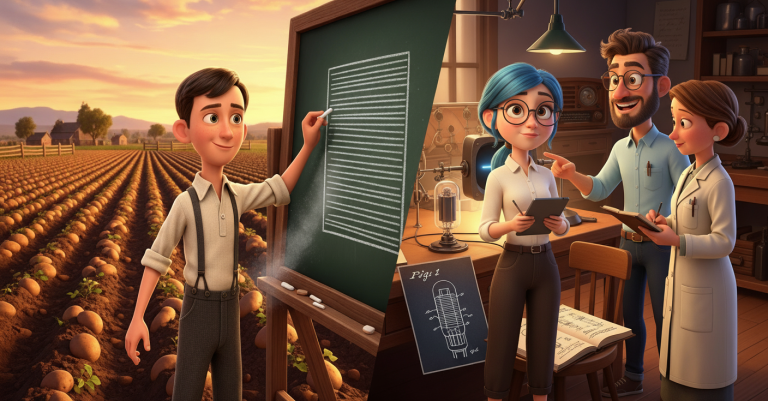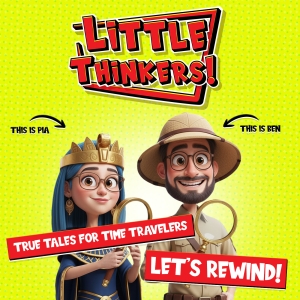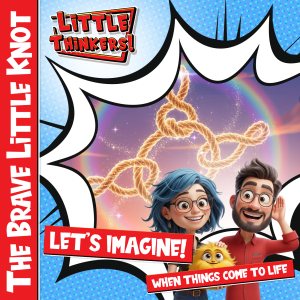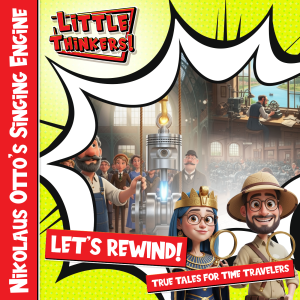The Farm Boy Who Drew Pictures Out of Thin Air
Imagine This Amazing Scene
Picture a fourteen-year-old boy walking behind a horse and plow on a dusty Idaho farm. The sun beats down as he watches the sharp metal blade cut perfectly straight lines across the brown earth. Suddenly, his eyes light up with the most incredible idea! What if pictures could travel through the air the same way – line by line, just like these neat furrows? This wasn’t just any daydream. This was the moment that would change every home in the world forever!
That boy was Philo Taylor Farnsworth, and he was about to invent something that would put magical glowing screens in nearly every room on Earth. Get ready for an amazing adventure about a quiet farm kid who battled giant companies, drew secret diagrams on chalkboards, and turned invisible electricity into living, moving pictures!
The Boy Behind the Plow
In 1922, life on the Farnsworth farm in Rigby, Idaho was hard work from sunrise to sunset. Fourteen-year-old Philo spent long days helping his family grow potatoes and tend animals. But this wasn’t just any ordinary farm boy – his mind was always buzzing with incredible ideas!
While other kids his age were thinking about baseball or fishing, Philo was fascinated by electricity and machines. He had already figured out how to fix broken farm equipment and even built his own radio! His family’s farmhouse was one of the first in the area to have electric lights, and young Philo was the one who wired it all up.
Did You Know?
Philo was so good with electricity that neighbors would bring their broken radios and motors to the teenage farm boy to fix! He was like a kid superhero with a toolbox instead of a cape.
But on that spring day in 1922, as he guided the plow across the field, something magical happened in his mind. He stared at those perfectly straight, parallel lines cutting through the soil and thought: “What if pictures could be sent through the air the same way – line by line?”
The Chalkboard That Changed Everything
A few days later at Rigby High School, young Philo couldn’t get his amazing idea out of his head. His chemistry teacher, Justin Tolman, noticed that the freshman seemed distracted and asked what was on his mind.
What happened next was absolutely incredible! Philo walked up to the chalkboard and began drawing. He sketched a rectangle, then filled it with thin horizontal lines from left to right. His hands were shaking a little – after all, he was just a freshman talking to a teacher about something that sounded like pure science fiction!
“See these lines?” Philo explained, pointing with the chalk. “A beam of electrons could sweep across a picture, line by line, just like plowing a field. The beam would get brighter or darker depending on what it sees. Then another tube could recreate those same lines on a screen!”
Mr. Tolman listened carefully. He didn’t laugh or tell Philo it was impossible. Instead, he asked thoughtful questions and even helped the boy add labels and arrows to the drawing. When the school bell rang, that simple chalk drawing on the blackboard held the secret to electronic television!
Fun Fact!
Mr. Tolman was so impressed by Philo’s idea that he kept a copy of that chalkboard drawing for years. That simple sketch would later become the most important piece of evidence in a huge courtroom battle!
From Dreams to Reality
For the next few years, Philo couldn’t stop thinking about his electronic television idea. He read every science magazine he could find, built radios in his family’s attic, and filled notebook after notebook with circuit diagrams and calculations.
But life wasn’t easy. When Philo was still a teenager, his father became very sick and died. The family struggled with money, and Philo had to work extra hard to help support them. He studied for a while at Brigham Young University but had to repair radios on the side just to pay for school.
Through all these challenges, that chalkboard idea kept calling to him like a distant star. Night after night, by the light of a single lamp, he would sketch and plan and dream about the day he could turn those drawings into a real machine.
The Big Move to San Francisco
In the late 1920s, something wonderful happened! Philo married his sweetheart, Elma Gardner (everyone called her Pem), and she believed in his crazy television dream just as much as he did. Even better, two businessmen from San Francisco – George Everson and Phil McCargar – heard about the young inventor and decided to give him a chance.
They rented a small laboratory space near Telegraph Hill in San Francisco. It wasn’t fancy – just a room with workbenches, some electrical equipment, and lots of determination. Pem became Philo’s partner in every way, keeping careful notes, ordering parts, and even learning how to operate the complicated machines!
Life Back Then
In the 1920s, most people got their entertainment from radio shows and movies in theaters. The idea of having moving pictures in your own living room seemed as impossible as having a rocket ship in your garage!
Building the Magic Box
The heart of Philo’s invention was something he called an “image dissector” – basically a special glass tube that could capture pictures and turn them into electrical signals. Building it was incredibly difficult!
The tube had to be almost completely empty of air, which meant running noisy vacuum pumps for hours. The glass had to be perfectly sealed, and the tiny parts inside had to be positioned just right. The first tubes failed. The second batch failed too. Coils burned out, seals leaked, and delicate wires snapped with tiny pops that meant starting all over again.
For months, the lab was filled with the smell of hot dust and the sound of frustrated sighs. Bills were piling up, and their investors were getting worried. But Pem kept everyone’s spirits up with her calm confidence, and Philo refused to give up on his farm-field dream.
Wow Moment!
Finally, one magical day, they built a tube that held its vacuum overnight. It sat on the workbench gleaming like a crystal promise – ready to make history!
The World’s First Electronic TV Picture
September 7, 1927 – a date that changed everything! The laboratory was warm with glowing lamps and tangled with cables running everywhere. On a little screen sat a painted glass plate with just a simple straight line on it.
Philo powered up his image dissector tube. For a long, heart-stopping moment, nothing happened. Then suddenly, there it was – a thin, bright line appeared on the receiving screen! When Philo rotated the glass plate, the line on the screen tilted and followed perfectly.
It was just a line. Plain and simple. But it was also the first successful electronic television picture in history! No spinning wheels, no mechanical parts – just electrons dancing in empty space, carrying a picture from one place to another.
The room fell completely silent. Then huge grins broke across everyone’s faces. They had done it! The chalkboard dream had become glowing reality!
Did You Know?
That first television picture wasn’t a person’s face or even a simple drawing – it was just a straight line! But that line represented something incredible: proof that pictures could travel through the air using nothing but electricity.
The First TV Stars
By 1928, Philo’s team was ready to show off their amazing invention to newspaper reporters. They climbed the stairs to the little laboratory and squinted into the bright lights. The team started by sending simple shapes, then letters of the alphabet.
Later, they tried something really exciting – a human face! Historians tell us that Pem often stood in front of the hot, bright camera lights. She had to close her eyes because the lights were so intense, but her face appeared on the screen in glowing lines. It was fuzzy and flickering, but it was definitely a real person’s face traveling through the air!
Word began to spread through the scientific community. This wasn’t just a clever trick – it was a whole new way to send pictures that could grow sharper and faster than anything anyone had imagined.
The Giant Wakes Up
When big companies heard about Philo’s success, they paid attention fast! The Radio Corporation of America (RCA) was a huge company led by a powerful businessman named David Sarnoff. They had their own plans for television and weren’t happy about some young farm boy getting there first.
In 1930, an RCA scientist named Vladimir Zworykin visited Philo’s San Francisco lab. He was very polite and asked lots of careful questions. He studied the image dissector closely and took detailed notes. When he left, Philo felt a little worried – and he was right to be!
Soon afterward, RCA announced their own television camera tube called the “iconoscope.” They claimed it was completely different from Philo’s invention. Lawyers started filing thick piles of legal papers, and a massive battle began over who really invented electronic television first.
David vs. Goliath
It was like a real-life David and Goliath story! On one side was young Philo with his small team and limited money. On the other side was RCA – a giant corporation with entire floors full of lawyers and millions of dollars to spend on the fight.
The Chalkboard Saves the Day
The legal battle moved to Washington, D.C., where patent experts had to decide who really invented electronic television first. The hearing room smelled like paper and ink, and serious-looking men in suits explained complicated technical details.
RCA’s lawyers were confident they would win. After all, they were a huge, respected company with famous scientists. But then something amazing happened that no one expected!
A witness stepped forward – it was Justin Tolman, Philo’s old high school teacher from Idaho! He told the patent examiners about a young farm boy who had drawn a remarkable diagram on a classroom chalkboard back in 1922. Mr. Tolman had kept that drawing (or recreated it from memory) all those years!
When the examiners saw that simple sketch of a rectangle filled with horizontal lines, the whole room fell silent. The drawing proved that Philo had conceived the key ideas for electronic television years before RCA’s scientists had even started working on the problem!
The Power of Teachers
Mr. Tolman’s careful attention to his student’s idea proved that teachers can change the world! If he hadn’t listened seriously to Philo’s crazy-sounding theory, or if he hadn’t kept that drawing, history might have been completely different.
Victory for the Farm Boy
In 1934, after years of legal battles and appeals, the U.S. Patent Office made its decision: Philo T. Farnsworth had indeed invented the key parts of electronic television first! The quiet farm boy had defeated the giant corporation.
That night, there was no wild celebration at the laboratory. The team just breathed huge sighs of relief. Pem wrote careful notes in her ledger, and Philo leaned against a workbench, smiling at the dusty old screen that had started it all.
The legal victory meant that Philo’s ideas were officially protected, giving him the right to license his inventions to other companies. But the road ahead was still difficult – building thousands of reliable television sets for families would be another huge challenge!
Television Grows Up
During the Great Depression of the 1930s, money was tight for everyone, but Philo kept working to improve his inventions. He moved his operations to Philadelphia and later to Fort Wayne, Indiana, where his team built better and better television sets.
Engineers refined the picture tubes to make images sharper. Assembly workers tested each set with simple pictures – a clock, a person’s face, someone tossing a baseball into a glove. Making one working television was hard enough, but making thousands that families could afford and operate was like climbing a second mountain!
Fun Fact!
The first television programs were incredibly simple compared to today’s shows. Sometimes the whole program was just someone sitting at a desk reading the news, or a single person singing a song!
The World Discovers Television
At the 1939 New York World’s Fair, television made its grand public debut! Bright screens flickered on display stands, and crowds of amazed visitors pressed close to see this miracle technology. Families could hardly believe that pictures and sound were traveling through thin air to appear on glowing screens.
By this time, RCA had agreed to license parts of Philo’s patents, which meant money finally started flowing back to his company. People began to see television not as a scientific curiosity, but as something they might actually want in their own homes.
Then World War II began, and everything changed. Factories that might have built television sets had to make military equipment instead. But after the war ended, television came back stronger than ever!
Television Takes Over the World
In the late 1940s and early 1950s, television exploded across America! Broadcasters filled the airwaves with comedy shows, baseball games, news programs, and children’s shows. Families bought TV sets by the thousands, gathering in living rooms to watch the glowing screens together.
Many of Philo’s original patents expired around 1947, which meant other companies could build televisions without paying him. His name often disappeared from the bright storefront signs, even though his inventions made it all possible. This made Philo feel proud of his success but also a little sad that people were forgetting who had started it all.
How TV Changed Everything
Television transformed how families spent their evenings! Instead of just listening to radio shows, they could now watch comedians, cowboys, and characters from around the world. Living rooms became like little movie theaters!
The Inventor Keeps Inventing
Even after television became successful, Philo’s curious mind couldn’t stop working on new ideas. He became fascinated with the possibility of clean nuclear fusion – a way to create energy by smashing tiny atoms together, just like what happens inside the sun!
He and his colleagues built a device called the Farnsworth-Hirsch fusor. Inside a special vacuum chamber, electrically charged particles rushed toward the center, creating a small, eerie blue glow. The device actually produced real nuclear reactions and generated neutrons – the same kind of particles that exist inside atomic nuclei!
While this fusor couldn’t generate enough energy to power a city, it proved that Philo’s inventive genius extended far beyond television. The device is still used today by scientists and students studying nuclear physics!
Did You Know?
Some of Philo’s fusor devices are still working today in research laboratories around the world! Students use them to learn about nuclear reactions and plasma physics.
A Quiet Hero Gets Recognition
In the late 1950s, something wonderful and strange happened. Philo appeared as a mystery guest on a popular TV game show called “I’ve Got a Secret.” He sat quietly on the stage, surrounded by the very technology he had invented, while panelists tried to guess his secret.
When they finally revealed that this modest, soft-spoken man had invented electronic television, the studio audience burst into amazed applause! It was a magical moment – the inventor meeting his invention under bright television lights, broadcast to millions of homes across the country.
Philo left the stage with a quiet wave, hoping that television would be used to educate, connect, and inspire people. He understood that inventions are like rivers – once you create them, they flow in directions that many different people help to steer.
The Legacy Lives On
Philo T. Farnsworth died in 1971 in Salt Lake City, Utah. That night, millions of families watched television, most of them never knowing the name of the quiet farm boy who had made it all possible. But his story didn’t end there!
Today, you can visit the Farnsworth Television Pioneer Museum in Rigby, Idaho, where his journey began. The small town proudly calls itself “the birthplace of television.” In Washington, D.C., a statue of Philo represents Utah in the U.S. Capitol building, honoring him as one of America’s greatest inventors.
Amazing Modern Connections!
Every screen you look at today – your family’s TV, computer monitors, tablets, and even smartphones – still uses the basic principle that fourteen-year-old Philo figured out behind that plow in 1922: building pictures line by line!
What We Can Learn from Philo’s Story
Philo Farnsworth’s incredible journey teaches us so many important lessons! First, amazing ideas can come from anywhere – even a dusty potato field in Idaho. You don’t need to live in a big city or come from a wealthy family to change the world.
Second, it shows how important it is to have people who believe in you. Pem supported Philo through years of failures and struggles. Mr. Tolman took his teenage student seriously and kept that precious chalkboard drawing. The San Francisco investors took a chance on an unknown young inventor.
Third, Philo’s story proves that persistence is magical. He faced thousands of failed experiments, ran out of money multiple times, and battled a giant corporation – but he never gave up on his farm-field dream.
Your Ideas Matter Too!
Just like Philo, you might have incredible ideas that seem impossible to adults. Don’t let anyone tell you that you’re too young to invent something amazing. Keep sketching, keep questioning, and keep dreaming big!
The Boy Who Drew Light Into Life
From a simple line scratched in chalk to the glowing screens that connect our world today, Philo Taylor Farnsworth’s story reminds us that the most powerful inventions often begin with the simplest observations. A teenage boy watched a plow cut neat lines across a field and wondered: “What if pictures could travel the same way?”
That question, drawn in chalk on a classroom blackboard in a tiny Idaho town, eventually lit up every home on Earth. The next time you watch a screen – any screen – remember the quiet farm boy who turned invisible electricity into visible magic, one line at a time.
Who knows? Maybe the next world-changing idea is already forming in your mind right now, just waiting for you to pick up a piece of chalk and start drawing!
